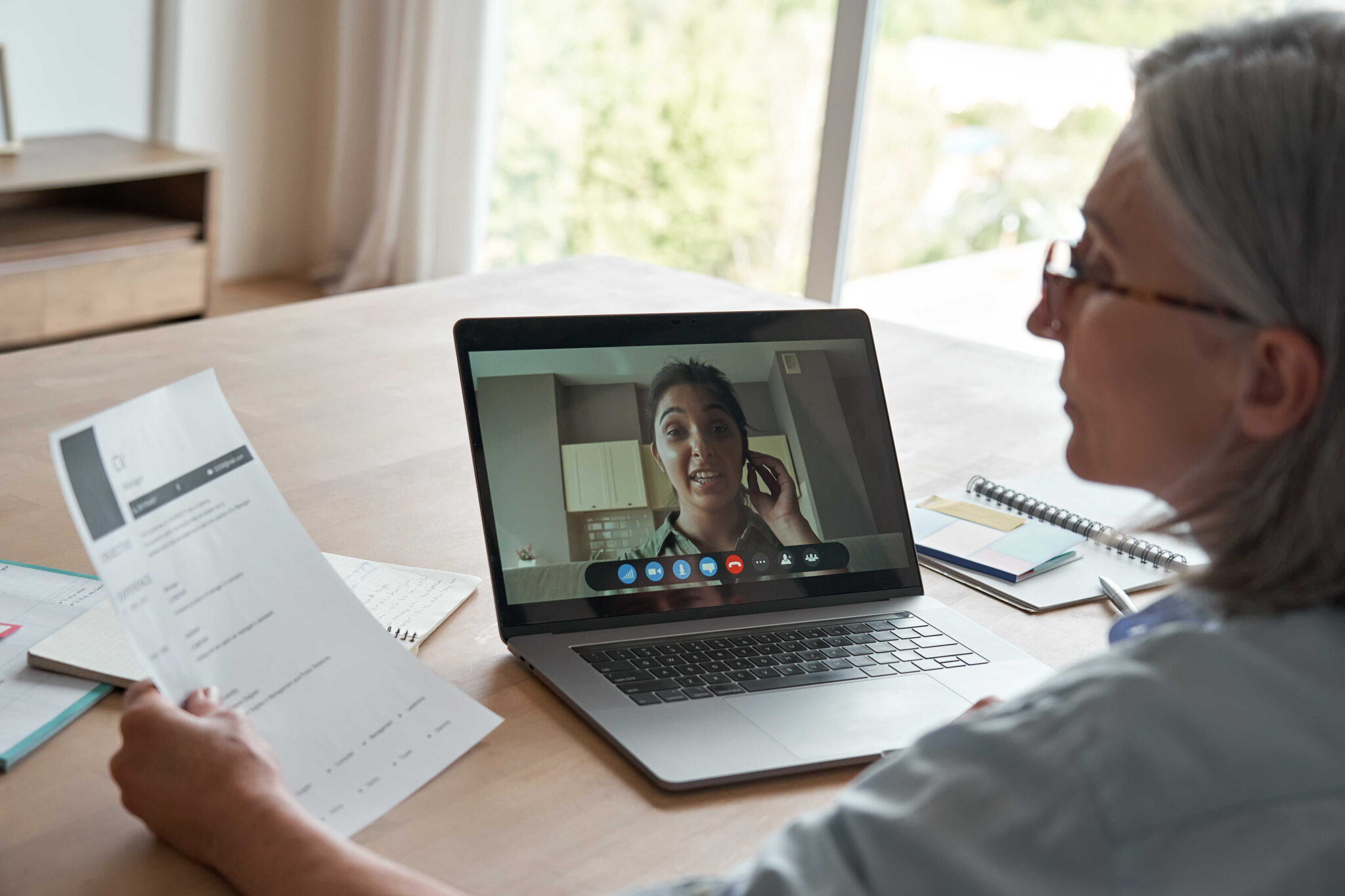11 Tips to Get You Ready For Your Virtual Interview

Your retail job interview is almost here. But before you get down to the serious business of showing your interviewer(s) just how perfect you are for the role, there are a few technical checks to make to ensure everything goes without a hitch…
Once upon a time, back when in-person interviews were all there was, this post would have looked very different. It would have featured lots of tips about planning your route to the interview, giving yourself plenty of time and making sure you were dressed for the occasion. But now that interviews for retail roles are far more likely to be held virtually, life should be an awful lot simpler, shouldn’t it?
Well, yes and no. It’s true, your interview shouldn’t be derailed because you missed your connecting train. But there’s a whole new range of things to consider before you say your first hello or answer your first question. We’re going to consider them here, but first, let’s clear up one important question…
Are virtual job interviews still a thing?
Yes. The pandemic may no longer require us all to stay at home, but employers have realised that virtual interviews are one legacy of Covid that they’re happy to retain, and for all sorts of reasons:
- They don’t have to bring all their interviewers together in the same physical space
- They minimise time, cost and inconvenience to everyone involved
- Candidates often feel more comfortable having an online interview than an in-person one
- Interviews aren’t thrown off course by interviewers/interviewees running late
- Plans aren’t upended by major events. If a storm shuts down the train network, the interviews should still go ahead
That doesn’t mean to say that every interview will be virtual. Some interviews may be in-person. And for multi-stage interviews, it’s likely that at least one interview will be ‘live’.
But for all the reasons noted above, virtual retail job interviews are here to stay. Here’s how to set yours up for success.
#1 Choose a laptop or desktop
We don’t all have laptops or desktop computers but, if you do, use it for your interview in preference to your phone.
>Phones typically take in a wider field of vision than a webcam which can lead to more distractions on the screen. And unless you have your phone in an appropriate stand/holder, you risk it falling over mid response, which is an excellent way to destroy the impact of your answer.
It goes without saying (but we’ll say it anyway) that you should never attempt to do a phone-cam interview while holding your phone.
Desktop or laptop, on the other hand, give you stability, a constant distance between you and the camera, and the opportunity to use a mouse or trackpad to share screens etc, so your finger doesn’t have to invade the screen.
#2 Check the tech
The software
Of course, Teams will work just fine. You’ve used it before. You know that just by clicking the interview link everything will work as it should. But tech has a funny way of tripping you up.
We’ve been there, 90 seconds before the meeting is due to start, screaming at our laptop because it won’t do something it did happily last week. Whether it’s Teams, Zoom, Meet or something else, download it or check it now, and do it again an hour or two ahead of the meeting.
The broadband
Not everyone can rely on decent broadband. If you’re in that position, don’t hope everything will be ok on the day.
If you know your broadband is always reliable in the morning but flaky in the afternoon (or vice versa) tell your interviewer or recruitment agency. They may be able to (re)schedule your interview for a better time.
If your broadband is unreliable but your mobile signal is strong, you might want to see whether tethering (that is, using your phone’s mobile signal to feed your laptop) might make things more stable. Find out more about tethering an Android and iOS phone.
Finally, if none of those are viable, it might be worth travelling to somewhere with a reliable broadband connection, just for the duration of the interview. If you do that, bear in mind the other points in this list to minimise distraction.
#3 Learn the tools
It’s possible that the only thing you’ll need to do during your interview is smile, look engaged and answer your interviewers’ questions. But what if you have a presentation to make? Or perhaps you’ll be required to comment or react to something you’re being shown onscreen.
It’s not that fumbling around to turn screen sharing on or off will necessarily lose you the job; it’s more a matter of keeping the focus where you want it. You want to avoid anything that distracts your interviewers or knocks you out of your rhythm.
That’s why it pays to familiarise yourself with the software. Remember, not every app operates the same way, or offers the same functionality as every other piece of conferencing software, so don’t assume that just because you can share your screen in Zoom you’ll be able to do the same thing seamlessly in Teams.
Top tip: Set up a conference call with a friend using the same software and practice using the tools.
#4 Lights, camera…
Just as important as setting the right background is setting the lighting. Position yourself so that any light source is in front of you, not behind. Rear light sources create silhouettes, making it look as though you’re trying to keep your identity hidden.
You want your interviewers to be able to see you clearly and read your facial expressions, so make sure your environment is generally well lit. That’s especially important if your interview is early/late in the day during the winter. When the light fades fast, it’s all too easy to find yourself sitting in the gloom without even realising it.
#5 Lights, camera…
Just as important as setting the right background is setting the lighting. Position yourself so that any light source is in front of you, not behind. Rear light sources create silhouettes, making it look as though you’re trying to keep your identity hidden.
You want your interviewers to be able to see you clearly and read your facial expressions, so make sure your environment is generally well lit. That’s especially important if your interview is early/late in the day during the winter. When the light fades fast, it’s all too easy to find yourself sitting in the gloom without even realising it.
#6 Position your webcam
Two things here: one, no interviewer wants to spend 30 minutes looking up your nostrils, so try and keep your webcam reasonably elevated. That’s usually easy with a laptop, but can be a little tricker with a desktop pc if the monitor doesn’t have an in-built camera. Take some time to test positions well ahead of the interview.
Second, and this is particularly important if you use more than one monitor, try to position the call window as close to the webcam as you can. That will make it appear as though you’re making eye contact with your interviewers. They’ll also get a clear view of your face, as opposed to spending the interview looking at your ear.
#7 Remove self-view
Want to know one of the biggest distractions in any video call? You. We all have a tendency to spend at least as much time looking at ourselves in a call as the person we’re talking to. In an interview, it’s even important to be as engaging and engaged as possible. So…
- Deactivate self-view
- Regularly look into the camera rather than at the screen, because if you’re looking into the camera you’re making eye contact.
#8 Interview wear still matters
There’s a balance to be struck here. It’s a virtual interview and you’re in your own home so it would be a little strange to appear on screen in a full business suit. Equally, it’s still a job interview, so turning up wearing a onesie won’t cut it either. Aim for smart business casual – shirt and trousers, perhaps a jacket.
Not only will that help you create a better impression; it’ll help you feel more confident too.
#9 Silence your phone
…And not just your phone. Close any apps and emails on your laptop that may throw up a distracting ping mid-interview.
#10 Test your setup
We’ve already said this repeatedly at several of the steps above, but if you haven’t done it yet, make a test call to check the tech, your understanding of the tools, your lighting, background and webcam position.
#11 Have a backup
What if your laptop battery dies? What if the broadband goes down? What if your neighbour is having building work done and the builders arrive five minutes ahead of your interview?
It’s worth having a few contingencies (alternative device, alternative location, alternative way of connecting) in place, just in case. It will make you feel more confident. It will also tell your interviewer something about your resourcefulness if you can overcome the unexpected with ease.
Now, you’re ready for the interview itself, which is the subject of our next post.
Want to find your next career move? Search our retail jobs now.
< Back to list


